Itzik Klein
Diffusion-Driven Inertial Generated Data for Smartphone Location Classification
Apr 20, 2025Abstract:Despite the crucial role of inertial measurements in motion tracking and navigation systems, the time-consuming and resource-intensive nature of collecting extensive inertial data has hindered the development of robust machine learning models in this field. In recent years, diffusion models have emerged as a revolutionary class of generative models, reshaping the landscape of artificial data generation. These models surpass generative adversarial networks and other state-of-the-art approaches to complex tasks. In this work, we propose diffusion-driven specific force-generated data for smartphone location recognition. We provide a comprehensive evaluation methodology by comparing synthetic and real recorded specific force data across multiple metrics. Our results demonstrate that our diffusion-based generative model successfully captures the distinctive characteristics of specific force signals across different smartphone placement conditions. Thus, by creating diverse, realistic synthetic data, we can reduce the burden of extensive data collection while providing high-quality training data for machine learning models.
Transformer-Based Robust Underwater Inertial Navigation in Prolonged Doppler Velocity Log Outages
Apr 10, 2025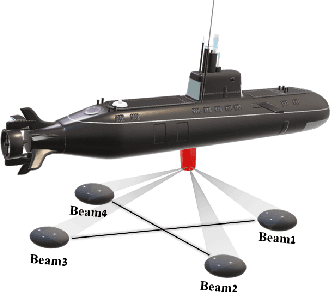
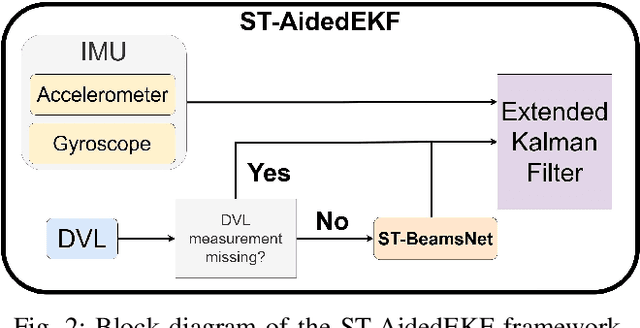

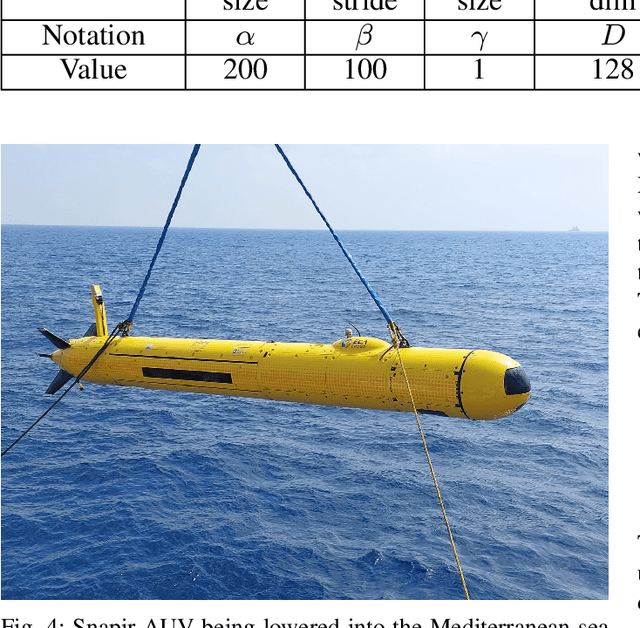
Abstract:Autonomous underwater vehicles (AUV) have a wide variety of applications in the marine domain, including exploration, surveying, and mapping. Their navigation systems rely heavily on fusing data from inertial sensors and a Doppler velocity log (DVL), typically via nonlinear filtering. The DVL estimates the AUV's velocity vector by transmitting acoustic beams to the seabed and analyzing the Doppler shift from the reflected signals. However, due to environmental challenges, DVL beams can deflect or fail in real-world settings, causing signal outages. In such cases, the AUV relies solely on inertial data, leading to accumulated navigation errors and mission terminations. To cope with these outages, we adopted ST-BeamsNet, a deep learning approach that uses inertial readings and prior DVL data to estimate AUV velocity during isolated outages. In this work, we extend ST-BeamsNet to address prolonged DVL outages and evaluate its impact within an extended Kalman filter framework. Experiments demonstrate that the proposed framework improves velocity RMSE by up to 63% and reduces final position error by up to 95% compared to pure inertial navigation. This is in scenarios involving up to 50 seconds of complete DVL outage.
Design and Experimental Validation of an Autonomous USV for Sensor Fusion-Based Navigation in GNSS-Denied Environments
Mar 30, 2025
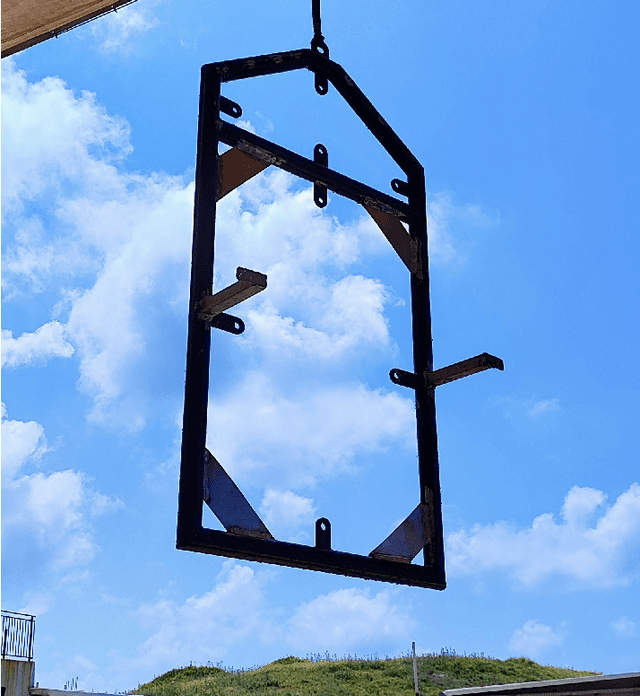
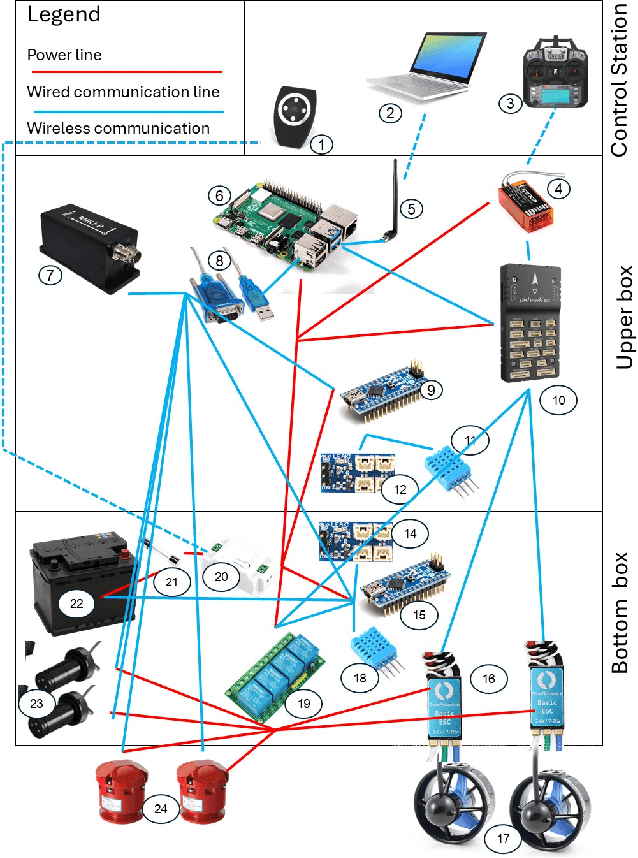
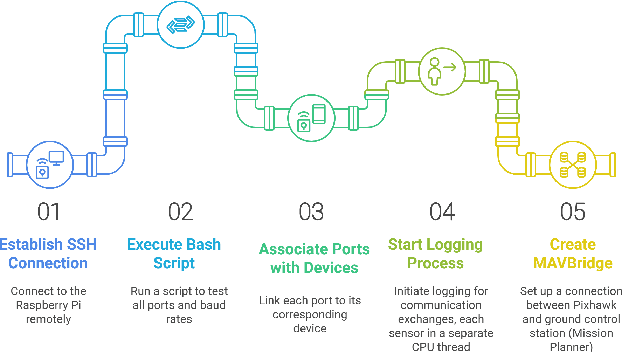
Abstract:This paper presents the design, development, and experimental validation of MARVEL, an autonomous unmanned surface vehicle built for real-world testing of sensor fusion-based navigation algorithms in GNSS-denied environments. MARVEL was developed under strict constraints of cost-efficiency, portability, and seaworthiness, with the goal of creating a modular, accessible platform for high-frequency data acquisition and experimental learning. It integrates electromagnetic logs, Doppler velocity logs, inertial sensors, and real-time kinematic GNSS positioning. MARVEL enables real-time, in-situ validation of advanced navigation and AI-driven algorithms using redundant, synchronized sensors. Field experiments demonstrate the system's stability, maneuverability, and adaptability in challenging sea conditions. The platform offers a novel, scalable approach for researchers seeking affordable, open-ended tools to evaluate sensor fusion techniques under real-world maritime constraints.
Enhancing Underwater Navigation through Cross-Correlation-Aware Deep INS/DVL Fusion
Mar 27, 2025Abstract:The accurate navigation of autonomous underwater vehicles critically depends on the precision of Doppler velocity log (DVL) velocity measurements. Recent advancements in deep learning have demonstrated significant potential in improving DVL outputs by leveraging spatiotemporal dependencies across multiple sensor modalities. However, integrating these estimates into model-based filters, such as the extended Kalman filter, introduces statistical inconsistencies, most notably, cross-correlations between process and measurement noise. This paper addresses this challenge by proposing a cross-correlation-aware deep INS/DVL fusion framework. Building upon BeamsNet, a convolutional neural network designed to estimate AUV velocity using DVL and inertial data, we integrate its output into a navigation filter that explicitly accounts for the cross-correlation induced between the noise sources. This approach improves filter consistency and better reflects the underlying sensor error structure. Evaluated on two real-world underwater trajectories, the proposed method outperforms both least squares and cross-correlation-neglecting approaches in terms of state uncertainty. Notably, improvements exceed 10% in velocity and misalignment angle confidence metrics. Beyond demonstrating empirical performance, this framework provides a theoretically principled mechanism for embedding deep learning outputs within stochastic filters.
A Data-Driven Method for INS/DVL Alignment
Mar 27, 2025Abstract:Autonomous underwater vehicles (AUVs) are sophisticated robotic platforms crucial for a wide range of applications. The accuracy of AUV navigation systems is critical to their success. Inertial sensors and Doppler velocity logs (DVL) fusion is a promising solution for long-range underwater navigation. However, the effectiveness of this fusion depends heavily on an accurate alignment between the inertial sensors and the DVL. While current alignment methods show promise, there remains significant room for improvement in terms of accuracy, convergence time, and alignment trajectory efficiency. In this research we propose an end-to-end deep learning framework for the alignment process. By leveraging deep-learning capabilities, such as noise reduction and capture of nonlinearities in the data, we show using simulative data, that our proposed approach enhances both alignment accuracy and reduces convergence time beyond current model-based methods.
AUV Acceleration Prediction Using DVL and Deep Learning
Mar 20, 2025Abstract:Autonomous underwater vehicles (AUVs) are essential for various applications, including oceanographic surveys, underwater mapping, and infrastructure inspections. Accurate and robust navigation are critical to completing these tasks. To this end, a Doppler velocity log (DVL) and inertial sensors are fused together. Recently, a model-based approach demonstrated the ability to extract the vehicle acceleration vector from DVL velocity measurements. Motivated by this advancement, in this paper we present an end-to-end deep learning approach to estimate the AUV acceleration vector based on past DVL velocity measurements. Based on recorded data from sea experiments, we demonstrate that the proposed method improves acceleration vector estimation by more than 65% compared to the model-based approach by using data-driven techniques. As a result of our data-driven approach, we can enhance navigation accuracy and reliability in AUV applications, contributing to more efficient and effective underwater missions through improved accuracy and reliability.
WMINet: A Wheel-Mounted Inertial Learning Approach For Mobile-Robot Positioning
Mar 17, 2025Abstract:Autonomous mobile robots are widely used for navigation, transportation, and inspection tasks indoors and outdoors. In practical situations of limited satellite signals or poor lighting conditions, navigation depends only on inertial sensors. In such cases, the navigation solution rapidly drifts due to inertial measurement errors. In this work, we propose WMINet a wheel-mounted inertial deep learning approach to estimate the mobile robot's position based only on its inertial sensors. To that end, we merge two common practical methods to reduce inertial drift: a wheel-mounted approach and driving the mobile robot in periodic trajectories. Additionally, we enforce a wheelbase constraint to further improve positioning performance. To evaluate our proposed approach we recorded using the Rosbot-XL a wheel-mounted initial dataset totaling 190 minutes, which is made publicly available. Our approach demonstrated a 66\% improvement over state-of-the-art approaches. As a consequence, our approach enables navigation in challenging environments and bridges the pure inertial gap. This enables seamless robot navigation using only inertial sensors for short periods.
Performance Analysis of Spatial and Temporal Learning Networks in the Presence of DVL Noise
Mar 07, 2025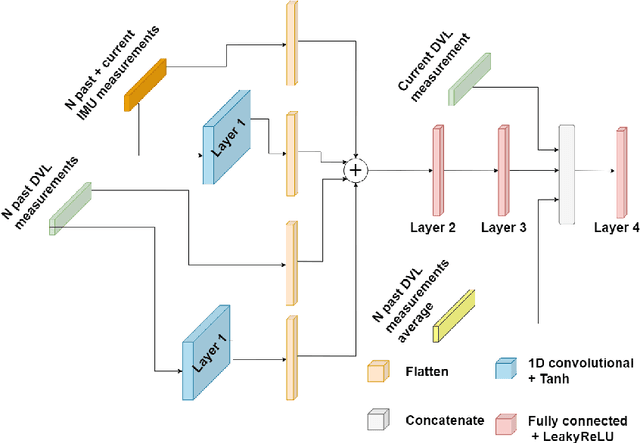
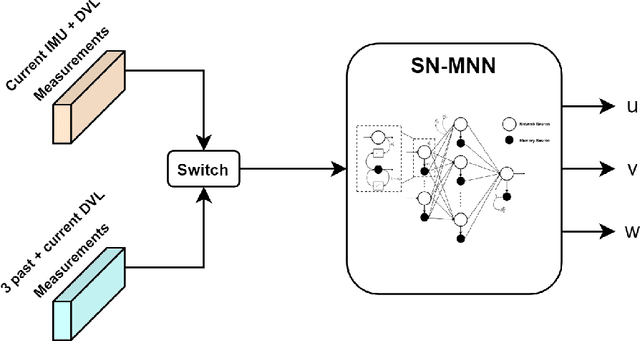
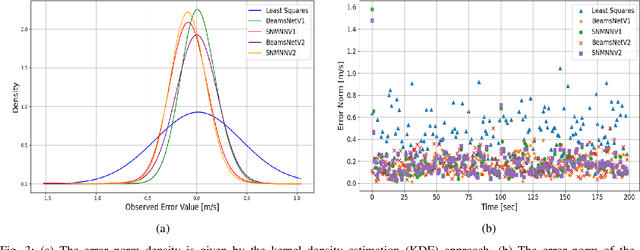
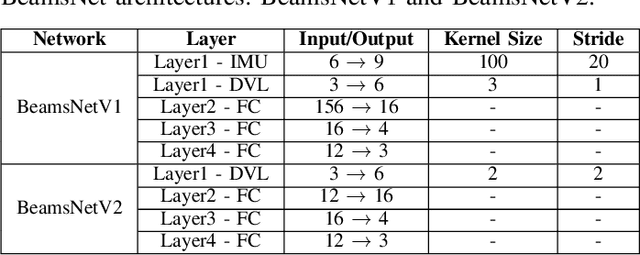
Abstract:Navigation is a critical aspect of autonomous underwater vehicles (AUVs) operating in complex underwater environments. Since global navigation satellite system (GNSS) signals are unavailable underwater, navigation relies on inertial sensing, which tends to accumulate errors over time. To mitigate this, the Doppler velocity log (DVL) plays a crucial role in determining navigation accuracy. In this paper, we compare two neural network models: an adapted version of BeamsNet, based on a one-dimensional convolutional neural network, and a Spectrally Normalized Memory Neural Network (SNMNN). The former focuses on extracting spatial features, while the latter leverages memory and temporal features to provide more accurate velocity estimates while handling biased and noisy DVL data. The proposed approaches were trained and tested on real AUV data collected in the Mediterranean Sea. Both models are evaluated in terms of accuracy and estimation certainty and are benchmarked against the least squares (LS) method, the current model-based approach. The results show that the neural network models achieve over a 50% improvement in RMSE for the estimation of the AUV velocity, with a smaller standard deviation.
Adaptive Neural Unscented Kalman Filter
Mar 07, 2025Abstract:The unscented Kalman filter is an algorithm capable of handling nonlinear scenarios. Uncertainty in process noise covariance may decrease the filter estimation performance or even lead to its divergence. Therefore, it is important to adjust the process noise covariance matrix in real time. In this paper, we developed an adaptive neural unscented Kalman filter to cope with time-varying uncertainties during platform operation. To this end, we devised ProcessNet, a simple yet efficient end-to-end regression network to adaptively estimate the process noise covariance matrix. We focused on the nonlinear inertial sensor and Doppler velocity log fusion problem in the case of autonomous underwater vehicle navigation. Using a real-world recorded dataset from an autonomous underwater vehicle, we demonstrated our filter performance and showed its advantages over other adaptive and non-adaptive nonlinear filters.
Quadrotor Neural Dead Reckoning in Periodic Trajectories
Feb 25, 2025Abstract:In real world scenarios, due to environmental or hardware constraints, the quadrotor is forced to navigate in pure inertial navigation mode while operating indoors or outdoors. To mitigate inertial drift, end-to-end neural network approaches combined with quadrotor periodic trajectories were suggested. There, the quadrotor distance is regressed and combined with inertial model-based heading estimation, the quadrotor position vector is estimated. To further enhance positioning performance, in this paper we propose a quadrotor neural dead reckoning approach for quadrotors flying on periodic trajectories. In this case, the inertial readings are fed into a simple and efficient network to directly estimate the quadrotor position vector. Our approach was evaluated on two different quadrotors, one operating indoors while the other outdoors. Our approach improves the positioning accuracy of other deep-learning approaches, achieving an average 27% reduction in error outdoors and an average 79% reduction indoors, while requiring only software modifications. With the improved positioning accuracy achieved by our method, the quadrotor can seamlessly perform its tasks.
 Add to Chrome
Add to Chrome Add to Firefox
Add to Firefox Add to Edge
Add to Edge